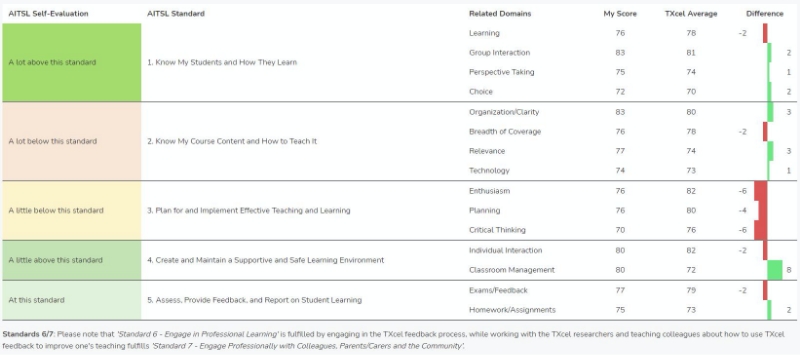Introduction to TXcel
The quality of education that students receive plays one of the most important roles in determining their success and, as research indicates, is the most important reason for parents' choice of schools for their children.
Secondary school teacher evaluations have typically focussed on indicators of student achievement and used ‘value-added' models. These have been criticised for lacking reliability and do not provide information on how or why students increase their performance or how to improve teachers' effectiveness. The aim is to find powerful ways for teachers who wish to know more about how their teaching impacts their students and, in a confidential way, to recommendations about how to enhance that impact.
The TXcel model was developed to provide a scientifically strong measurement tool that provides teachers with diagnostic and confidential feedback on how to improve their teaching. The model draws on expertise from internationally renowned educational psychologists and researchers, Prof. Herb Marsh (Australian Catholic University), and Prof. John Hattie.
Purpose of TXcel
The TXcel feedback Portal assists secondary school teachers to enhance their teaching in the context of the Australian Institute for Teaching and School Leadership (AITSL) professional standards.
Each teacher's online profile is personalised and confidential to them. It is intended that the TXcel Portal will provide reliable, diagnostic feedback about their teaching by including:
- Confidential feedback provided to teachers
- Benchmarking and filter options allowing teachers to compare their scores to teacher-groups most meaningful to them (e.g. subject area, year group, class level, etc.)
- A measure of students' perceptions of growth in teachers' classes across key outcomes
- Indicators of teachers' progress against the AITSL Standards
- Qualitative student feedback on areas that students find effective as well as areas for improvement
- Research-based strategies to enhance teaching aspects
The information provided through the TXcel Portal is designed for:
- Personal reflection on teaching practices
- Professional development planning
- Identification of teaching strengths
- Understanding students' learning experiences
- Diagnosis of areas for further attention, as identified by specific classroom context and teaching style
- Reference when undertaking supervision or mentorship
Information derived from the TXcel Portal is not intended to provide a basis of comparisons between individual teachers, or be used for performance appraisals. It is a professional learning tool designed to support the continued improvement of educators within the context of their teaching setting.
Teachers may benefit from discussing their results with colleagues, coaches, department heads or personal mentors to help identify appropriate learning objectives, resources, training and classroom strategies. However, it will be up to each teacher to decide whether they wish to share this information.
The TXcel Model
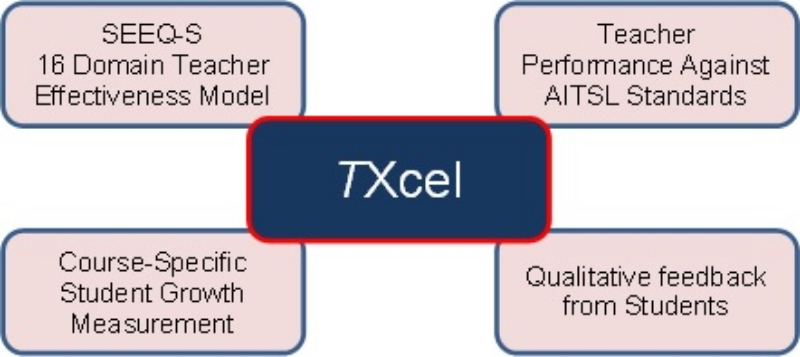
SEEQ-S Model
A core element of the TXcel model is the Student Evaluation of Educational Quality-Schools (SEEQ-S) instrument. This empirically validated survey was developed by lead educational psychologist and researcher, Prof. Herb Marsh (Australian Catholic University), in association with MMG Education.
The SEEQ-S student evaluation survey (Marsh, Dicke and Pfeiffer, 2019) has been extended to include 16 dimensions that span Feldman's (1976) multidimensional categories of teaching effectiveness. In doing so, the model creates an even more expansive and comprehensive coverage of modern teaching practices in schools today. Much attention has been given, in the development of the instrument to align with the AITSL Professional Standards for teachers.
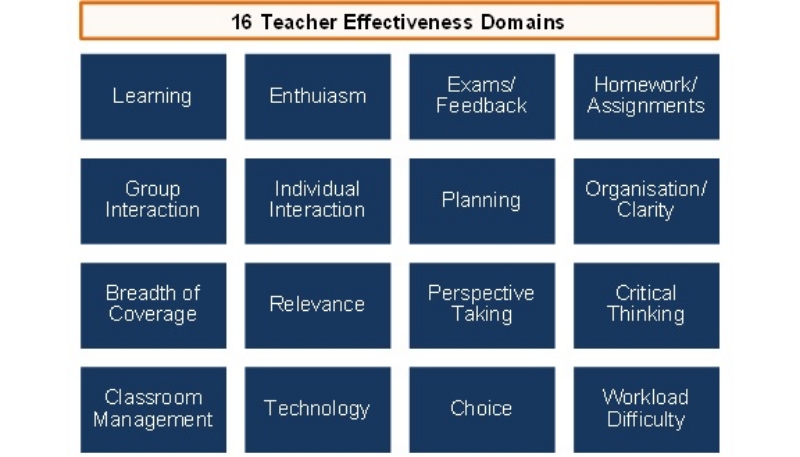
Course Specific Student Growth
Effective teaching yields student benefits. If teachers are truly effective, we expect that students will make measurable progress during a course. To test this, the TXcel model includes a ‘Course-Specific Student Growth Questionnaire' (working party consisting of Dr. J. Reeve, Prof. J. Hattie, Prof. H. Marsh, and Dr. T. Dicke), adopting a skills-based approach to conceptualise 6 course-specific student outcomes (see Cheon, Reeve and Moon, 2012).
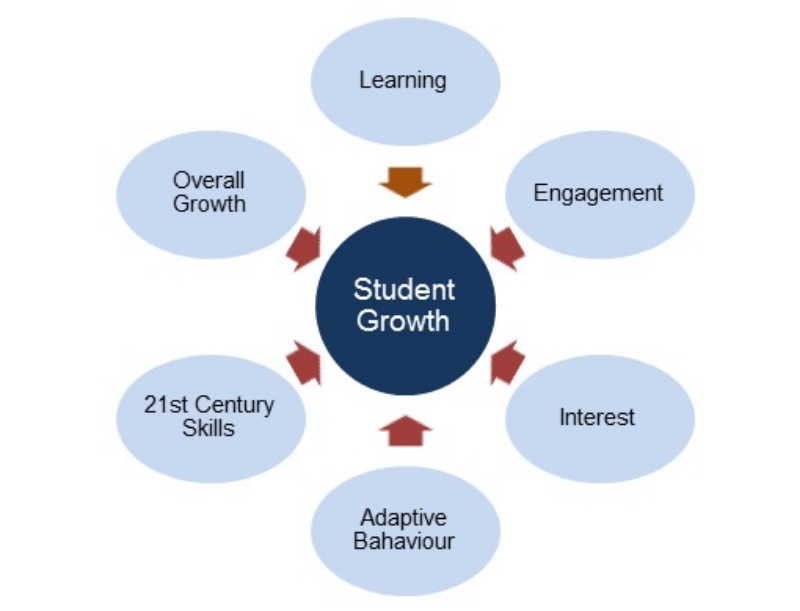
AITSL Standards
The Australian Professional Standards for Teachers (Australian Institute for Teaching and School Leadership, 2016) have been developed to guide teachers in their professional development.
The TXcel model has translated the AITSL Standards into practice by developing a benchmark scale (working party consisting of Prof. J. Hattie, Prof. H. Marsh, Dr. J. Reeve, and Dr. T. Dicke). Teachers are asked to self-rate items to reflect the standards aimed at classroom teaching.
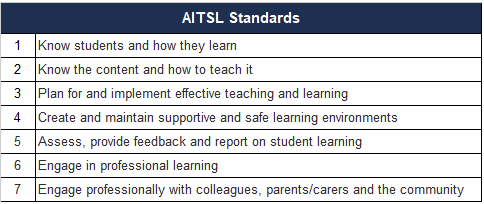
|
AITSL Standard |
|
|
1 |
Know My Students and How They Learn |
|
2 |
Know My Course Content and How to Teach It |
|
3 |
Plan for and Implement Effective Teaching and Learning |
|
4 |
Create and Maintain a Supportive and Safe Learning Environment |
|
5 |
Assess, Provide Feedback, and Report on Student Learning |
|
6 & 7 |
Standard 6 – 'Engage in Professional Learning'is fulfilled by engaging in the TXcel feedback process
Standard 7 – ‘Engage Professionally with Colleagues, Parents/Carers and the Community' is fulfilled when teachers work with the TXcel researchers and teaching colleagues about how to use TXcel feedback to improve one's teaching '. |
Open-Ended Feedback from Students
The TXcel survey invites students to provide teachers with anonymous, written feedback with regard to course strengths and opportunities for improvement. In our experience, teachers have found that such feedback enriches the overall feedback process and provides valuable insights that compliment quantitative results in other areas.
TXcel Strategies
A comprehensive list of teaching strategies is described under each teaching domain. These strategies have been suggested and used by outstanding educators across a range of institutions and disciplines. Educators found these strategies most beneficial when,after considering all the ideas,they selectedno more than three or fourwhich appeared potentially most profitable andmade a commitmentto apply or adapt them to improve their teaching effectiveness.
Some of the strategies provided have been adapted and developed from materials available in Marsh and Roche (1994).
The TXcel Process
The following schematic details the TXcel process and how it is used to assist teaching staff with their continual improvement and professional development.
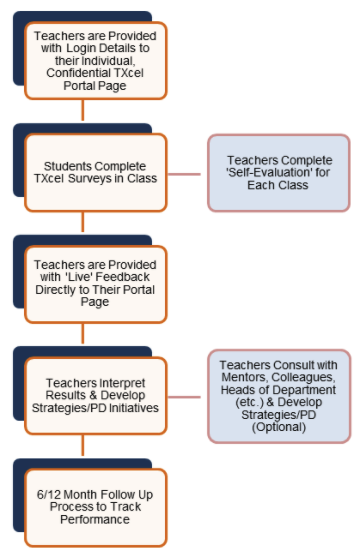
Testimonials – TXcel Portal
I found the TXcel process very good- easy and informative”
- Head of Middle School/ Director of Studies
“I must say I was quite impressed with the design of your report”
- Head of Professional Practice and Learning
“This is outstanding reporting for the teacher feedback tool! ... The beginning of something very special for teachers to use in reflection to inform their practice. I would encourage every teacher to do this if, and when the opportunity arises. Fantastic!”
- Head of Department
“I found it amazing feedback. Very useful and small enough class sizes that I could read through all the comments.”
- Teacher
I think that the survey is an excellent way of seeking feedback that we wouldn't otherwise get from our students. Overall, I was very happy with the process and the feedback I received”
- Teacher
“I found the results of the survey well-presented and well organised. I was able to use the results of the student survey for Graduate 2 confirmation evidence and reflection purposes”
- Teacher
Example of Output from the Teacher Portal
Teaching Domain Results
The overall Teaching Domains results show the teachers' overall scores for each of the 16 Teaching Domains for all of their classes. Teachers have the ability to display their scores compared to the following filters:
- TXcel Benchmark Average
- Previous Results (if the teacher has previously run the survey)
- High/Low Markers – Areas of personal strengths/weaknesses relative to other teachers (i.e. scores exceeding ± 1 standard deviation from all teachers' mean).areas where the teacher is performing
- The Teachers' Self Evaluation Score for each Domain
- Confidence Intervals
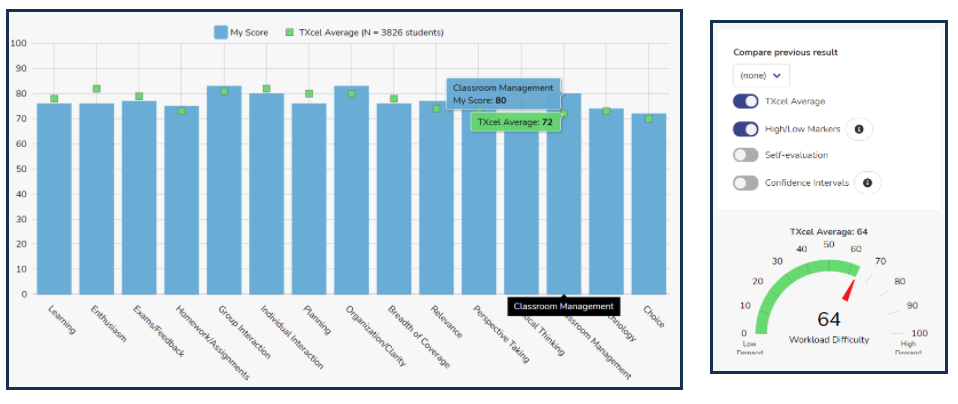
Individual Class Results
The Individual Class Results show the teachers' overall scores for each of their classes for a particular Teaching Domain (e.g. Exams/Feedback).
Teachers have the ability benchmark their scores against the following filters:
- Year Group
- Subject Area (e.g. Mathematics, English, etc.)
- Class Level (e.g. Low, Intermediate, High)
- The Teachers' Self Evaluation Score for each Domain
- Confidence Intervals
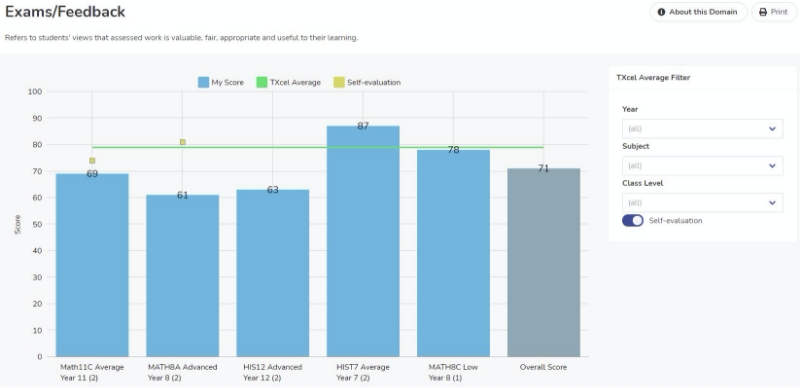
Student Growth Results
The Student Growth Results show teachers' scores for their students' growth compared to the TXcel Database average. Specific Teaching Domains are aligned to the 5 Growth Areas to assist with targeted strategies for improvement.
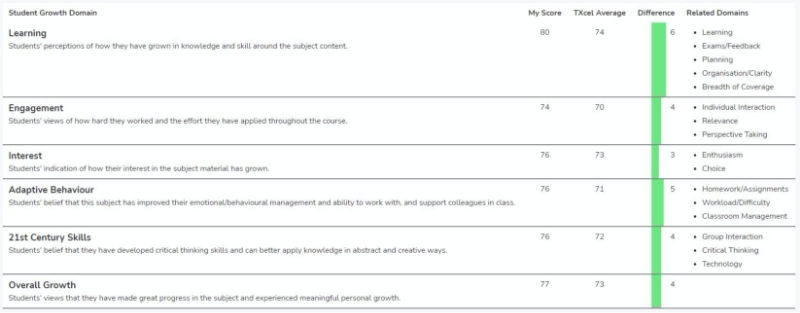
AITSL Teaching Standards Profile
The AITSL Teachign Standards Profile show teachers' scores for Teaching Domains that align with the first 5 AITSL teaching Standards compared to the TXcel Database average (Standards 6 & 7 are satisfied by utilising the TXcel model). Specific Teaching Domains are aligned to the AITSL Standards to assist with targeted strategies for improvement.
